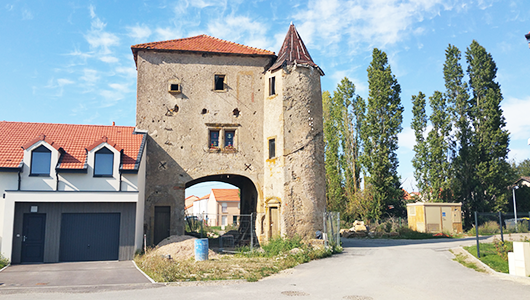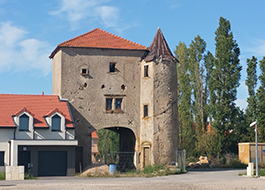Fleury
Durée visite : 20 minutes
Moyen : Pédestre
C’est un village du Saulnois qui dépendait de la province des Trois-Évêchés. Le Saulnois est une ancienne division du pays messin, comprenant la plus grande partie des cantons de Verny et de Pange, ainsi qu’une partie de celui de Vigy. Il comptait 77 communautés, tant villages que hameaux. Fleury fut détruit en 1352 par l’armée de Marie de Blois, régente de Lorraine. Le village était partagé en deux bans : celui de l’abbaye Sainte-Glossinde de Metz d’une part, celui de l’hôpital Saint-Nicolas de Metz, de l’autre. En février 1490, René II, duc de Lorraine en guerre contre Metz, fit établir son quartier général à Sainte-Ruffine. De là, il envoya des coureurs porter destruction dans les campagnes du pays messin. Tous les villages, depuis Pouilly et Verny jusqu’à Laquenexy, en passant par Fleury, furent brulés.
It is a village in Saulnois that depended on the province of the Three Bishops. The Saulnois is an ancient division of the Messian country, comprising most of the cantons of Verny and Pange, as well as part of that of Vigy. There were 77 communities, both villages and hamlets. Fleury was destroyed in 1352 by the army of Marie de Blois, regent of Lorraine. The village was divided into two bans: that of the abbey of Sainte-Glossinde de Metz on the one hand, that of the hospital Saint Nicholas of Metz, on the other. In February 1490, René II, Duke of Lorraine at war with Metz, had his headquarters established at Sainte-Ruffine. From there he sent runners to bring destruction to the countryside of the Messian country. All the villages, from Pouilly and Verny to Laquenexy, via Fleury, were burned.
Es ist ein Dorf in Saulnois, das von der Provinz der Drei-Bistümer abhängig war. Saulnois ist eine ehemalige Teilung des Messin-Landes, die den größten Teil der Kantone Verny und Pange sowie einen Teil der Kantone Vigy umfasst. Es gab 77 Gemeinden, sowohl Dörfer als auch Weiler. Fleury wurde 1352 von der Armee der Regentin von Lothringen, Marie de Blois, zerstört. Das Dorf war in zwei Bans aufgeteilt: das Dorf der Abtei Sainte-Glossinde de Metz auf der einen Seite, das des Krankenhauses Saint-Nicolas de Metz auf der anderen. Im Februar 1490 ließ René II., herzog von Lothringen im Krieg gegen Metz, sein Hauptquartier in Sainte-Ruffine errichten. Von dort aus schickte er Läufer, um die Zerstörung in die Land des messinischen Land zu bringen. Alle Dörfer, von Pouilly und Verny über Fleury bis Laquenexy, wurden verbrannt.

D’or à la fleur de lys d’azur, à la bordure du même.
La fleur de lys rappelle l’étymologie de la localité. La bordure indique que l’abbaye de Sainte Glossinde y avait des biens.
Gold with the flower of azure lilies, at the edge of the same.
The lily flower recalls the etymology of the locality. The border indicates that the abbey of Saint Glossinde had property there.
Von Gold bis zur Blüte der blauen Lilie, am Rande des gleichen.
Die Lilienblüte erinnert an die Etymologie des Ortes. Der Rand weist darauf hin, dass die Abtei von Sainte Glossinde dort Besitz hatte.

Les habitants et les habitantes de Fleury s’appellent les Fleuriens et les Fleuriennes.
The inhabitants of Fleury are called the Fleuriens and the Fleuriennes.
Die Bewohner von Fleury heißen die Fleuriens und die Fleuriennes.
Les points de visites
La tour Saint-Nicolas date de 1580. Elle est le dernier vestige de la ferme du même nom. Elle appartenait alors à l’hôpital Saint-Nicolas de Metz. Elle a la particularité d’être construite en partie avec des stèles funéraires gallo-romaines. Le bâtiment est composé d’un passage sous porte cochère. Le premier et le deuxième étage comportent chacun une pièce de 45 m2. On accède à ces pièces par un escalier en colimaçon depuis la façade Sud, côté ferme. Sur la façade Nord, vers Metz, une stèle funéraire gallo-romaine représente une femme. Elle est communément interprétée comme la représentation de Saint-Nicolas. Sur la même façade, se trouve une niche ayant abrité une Vierge à l’enfant.
Ce corps de ferme fait actuellement l’objet d’un projet immobilier. Il est appelé Domaine de la Tour. Les travaux à effectuer concerne uniquement le confortement du bâtiment. Cela évitera que celui-ci ne se dégrade irrémédiablement. La restauration est effectuée par les Compagnons de la Tour Saint-Nicolas.
The St. Nicholas Tower dates back to 1580. It is the last remnant of the farm of the same name. It belonged to St. Nicholas Hospital in Metz at the time. It has the distinction of being built in part with Gallo-Roman burial steles. The building is composed of a passage under a cochère gate. The first and second floors each have a 45-square-metre room. These rooms are accessed via a spiral staircase from the south façade, on the firm side. On the north façade, towards Metz, a Gallo-Roman funerary stele depicts a woman. It is commonly interpreted as the representation of St. Nicholas. On the same façade, there is a niche that has housed a Virgin to the child.
This farmhouse is currently the subject of a real estate project. It is called Tower Domain. The work to be carried out is only concerned with the comfort of the building. This will prevent it from degrading irreparably. The restoration is carried out by the Companions of the St. Nicholas Tower.
Der Nikolausturm stammt aus dem Jahr 1580. Sie ist das letzte Überbleibsel der gleichnumigen Farm. Sie gehörte damals dem St. Nikolaus-Krankenhaus in Metz an. Es hat die Besonderheit, zum Teil mit gallo-römischen Grabstelen gebaut werden. Das Gebäude besteht aus einem Durchgang unter der Tür. Der erste und der zweite Stock verfügen jeweils über einen Raum von 45 m2. Man erreicht diese Räume über eine Wendeltreppe von der Südfassade auf der Festseite. An der Nordfassade in Richtung Metz stellt eine gallo-römische Grabstele eine Frau dar. Sie wird allgemein als Darstellung von St. Nikolaus interpretiert. Auf derselben Fassade befindet sich eine Nische, in der eine Jungfrau dem Kind unterstand.
Dieses Bauernhaus ist derzeit Gegenstand eines Immobilienprojekts. Es wird « Turm-Gebiet » genannt. Die durchzuführenden Arbeiten betreffen ausschließlich die Belastung des Gebäudes. Dadurch wird verhindert, dass dieser sich unwiederbringlich verschlechtert. Die Restaurierung erfolgt durch die Compagnons de la Tour Saint-Nicolas.
.
.
L’église Notre-Dame-de-la-Nativité datait de 1767. Elle fut détruite en septembre 1944, par un bombardement américain. Celui-ci visait un émetteur allemand situé dans le clocher. La nouvelle église est construite en 1962 par Georges-Henri Pingusson. Ce dernier est né à Clermont-Ferrand en 1894. Il est mort à Paris en 1978. C’est un architecte, urbaniste, enseignant et ingénieur français. Résolument novateur, il participe à l’Union des artistes modernes, aux côtés de Tony Garnier, Le Corbusier ou Jean Prouvé. Il devient architecte en chef de la reconstruction de la Sarre de 1945 à 1950, puis du département de la Moselle, de 1946 à 1957. Il conçoit la caserne des pompiers de Metz, l’église Saint-Pierre de Borny. Son principal travail est situé à Paris. C’est le Mémorial des Martyrs de la Déportation sur l’Ile de la Cité. Il le réalise entre 1954 et 1964.
Couvert de toitures à deux pans de faible pente, l’édifice se développe à partir d’un plan rectangulaire, orienté selon un axe Est/Ouest. Il existe un décalage des hauteurs d’évacuation des eaux de pluies des toitures. Il rappelle le gabarit caractéristique du bâti d’un village-rue. Implanté à l’angle nord du volume, le clocher, de base ovoïde et percé d’ouvertures triangulaires, marque l’entrée latérale de l’église. L’accès au lieu de culte se fait par un jardin planté de tilleuls. Sa vocation est de faire la transition entre le monde matériel et le Sacré.
The Church of Our Lady of the Nativity dates back to 1767. It was destroyed in September 1944 by an American bombing. This targeted a German transmitter located in the bell tower. The new church was built in 1962 by Georges-Henri Pingusson. He was born in Clermont-Ferrand in 1894. He died in Paris in 1978. He is a French architect, urban planner, teacher and engineer. Resolutely innovative, he participated in the Union of Modern Artists, alongside Tony Garnier, Le Corbusier and Jean Prouvé. He became chief architect of the reconstruction of the Saarland from 1945 to 1950, then of the department of Moselle, from 1946 to 1957. He designed the Metz Fire Station, St. Peter’s Church in Borny. His main work is located in Paris. It is the Memorial of the Martyrs of Deportation on the Island of the City. He made it between 1954 and 1964.
Covered with roofs with two sides of low slope, the building develops from a rectangular plan, oriented on an east/west axis. There is a shift in the heights of rainwater drainage from roofs. It recalls the characteristic size of the building of a village-street. Located at the north corner of the volume, the bell tower, with an ovoid base and pierced with triangular openings, marks the side entrance of the church. Access to the place of worship is through a garden planted with lime trees. Its vocation is to make the transition between the material world and the Sacred.
Die Kirche Notre-Dame-de-la-Nativité stammt aus dem Jahr 1767. Sie wurde im September 1944 durch einen amerikanischen Bombenangriff zerstört. Dieser zielte auf einen deutschen Sender im Kirchturm ab. Die neue Kirche wurde 1962 von Georges-Henri Pingusson erbaut. Letzterer wurde 1894 in Clermont-Ferrand geboren. Er starb 1978 in Paris. Er ist ein französischer Architekt, Stadtplaner, Lehrer und Ingenieur. Er ist entschieden innovativ und beteiligt sich an der Union der modernen Künstler, zusammen mit Tony Garnier, Le Corbusier oder Jean Prouvé. Von 1945 bis 1950 wurde er Chefarchitekt für den Wiederaufbau des Saarlandes und von 1946 bis 1957 im Departement Moselle. Er entwirft die Feuerwache von Metz, die Kirche St. Peter in Borny. Seine Hauptarbeit befindet sich in Paris. Es ist die Gedenkstätte für die Märtyrer der Deportation auf der Ile de la Cité. Er realisiert es zwischen 1954 und 1964.
Das Gebäude ist mit zwei Hangdächern bedeckt und entwickelt sich von einer rechteckigen Ebene, die nach einer Ost-West-Achse ausgerichtet ist. Es gibt eine Verschiebung der Abflusshöhen von Regenwasser von den Dächern. Es erinnert an die charakteristische Schablone des Gebäudes eines Straßendorfes. Im nördlichen Winkel des Volumens befindet sich der Glockenturm, eiförmige Basis und durchbohrt mit dreieckigen Öffnungen, markiert den seitenseitigen Eingang zur Kirche. Der Zugang zum Gotteshaus erfolgt über einen garten mit Linden bepflanzt. Seine Berufung ist es, den Übergang von der materiellen Welt zum Heiligen zu machen.







